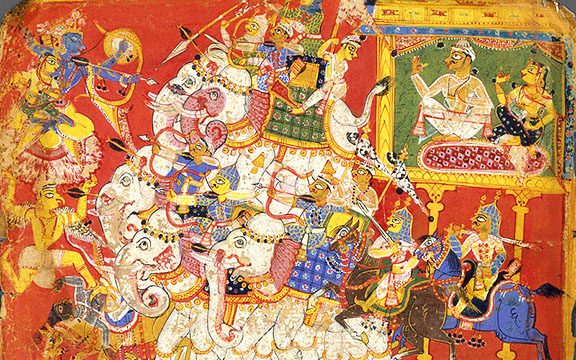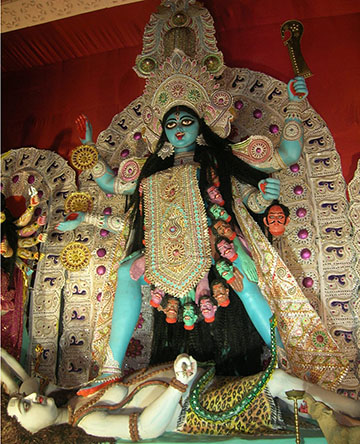 The grand festival season has already begun! No matter where we live in this vast country and what faith we belong to, if there’s one festival that connects us together, it’s Diwali. While most other festivals are celebrated in small pockets in the country, Diwali is celebrated across the length and breadth of India. Of course, being the diverse country India is, every community, every region, every culture has its own way of celebrating this festival of lights. The traditions and celebrations are many. And so are the stories! Mythology and folklore go hand in hand and we often find different versions of mythological legends behind Diwali woven into the folklore.
The grand festival season has already begun! No matter where we live in this vast country and what faith we belong to, if there’s one festival that connects us together, it’s Diwali. While most other festivals are celebrated in small pockets in the country, Diwali is celebrated across the length and breadth of India. Of course, being the diverse country India is, every community, every region, every culture has its own way of celebrating this festival of lights. The traditions and celebrations are many. And so are the stories! Mythology and folklore go hand in hand and we often find different versions of mythological legends behind Diwali woven into the folklore.
For most, Diwali is the celebration of King Rama’s return to Ayodhya after his victory over Ravana, as told in the epic Ramayana. Others trace the origin of the festival to the Mahabharata, where Diwali is marked by the return of the five Pandavas from their exile in the forest. In another version from the mountains of Himachal, the great war of Mahabharata began on the first day of Diwali. During the celebration there, locals dance and sing folklores related to the epic Mahabharata. Another tale behind the festival marks the day of Narak Chaturdashi, the 14th day of the second half of the month Ashvin and the second day of Diwali, as the day when Lord Krishna slew the devil Narakasur and freed the 16,000 women he had held captive.

(photo: Krishna Battles the Armies of Narakasura)
Sometimes, folk tales have a more interesting take on their mythological roots. In Andhra folklore, Narakasur is believed to have been killed not by Krishna but by his wife Satyabhama. As the story goes, Narakasur could only be killed by his own mother, and his mother had died when he was a child. This had rendered him immortal in a sense. However, Krishna was aware that Satyabhama was a reincarnation of Narakasur’s mother and therefore he took her to the battlefield, where she killed the demon.
Another day, considered to be part of the Diwali celebration, is Bhau Beej (as referred to in Goa, Maharashtra and Karnataka). It is also known as Bhai Tika, Bhathru Dwithiya, Bhai Dooj in the northern parts of the country. As the story goes, the God of Death, Yamraj, visited his sister Yami (or Yamuna) on this special day. For this reason, the day is also known as Yama Dwitiya. Another story links this day to the Narkasur-Krishna story. It says that Krishna returned victorious to his sister Subhadra after killing Narakasur and was welcomed by her with rituals like tilak and aarti.
In later times, the festival of Diwali also came to be associated with the coronation of King Vikramaditya, the benevolent and brave emperor of Ujjain, and took place on the day of Padwa or Varshapratipada. According to Jain texts, Lord Mahavira, the twenty-fourth and last tirthankara, is said to have attained Nirvana on the day of Diwali.
Yet another story links the day of Balipratipada to the story of King Mahabali and Lord Vishnu’s fourth incarnation, Vamana. Balipratipada is said to be the day when Vamana sent the ambitious King Mahabali back to the underworld on the request of Indra and other gods. However, it’s believed that Mahabali was a benevolent king and therefore he was given a boon by Lord Vishnu so that he could visit his kingdom once a year. The festival of Onam is celebrated in Kerala to mark the annual visit of King Mahabali to his people.
In West Bengal, Goddess Kali is worshipped on Diwali. Kali was born from Goddess Durga’s forehead to restore peace in heaven and on earth. After destroying all the demons, she wore a garland of the slain demon heads around her neck. However, she lost control and started destroying anything that came in her way. To stop her, Lord Shiva lay down in her path and, upon unknowingly stepping on him, she recovered her senses.
Given the many different stories and events related to the festival, it is not surprising then that Diwali is celebrated on different dates around the country. In Himachal Pradesh, at Ani and Nirmand in Kullu district, Shillai in Sirmaur district, and Chopal in Shimla district, Diwali is celebrated a month after it’s celebrated in the rest of the country. This is the reason that it’s not simply called Diwali; it’s known as Budhi Diwali (meaning old Diwali). As victorious Rama returned, the news spread in his kingdom. The people of Ayodhya were ecstatic at their beloved King’s return after 14 long years and therefore celebrated by lighting lamps and distributing sweets. But because the mountainous northern region was far away from the capital, it took a month for the news to reach there. They started the celebrations as soon as they got the news; however, it was a month after the celebrations took place in the rest of the kingdom. The festival, in the part of the country, is also associated with the killing of two demons Dano and Asura, who lived in Nirmand disguised as snakes. Animal sacrifice, therefore, is one of the important rituals of Buddhi Diwali.
Whether you’re a believer of these legends and stories or not, there is one thing you’re sure to do on Diwali, and that is to celebrate it with lights. Homes, streets, parks and, most importantly, people’s hearts are illuminated with a warm golden glow during the festival season, and this is what brings the entire country together during the festive season.
(Source: thebetterindia.com)


